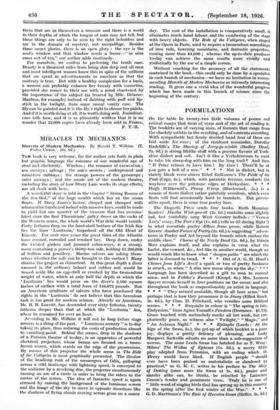Unstin." 10S. - 6d) — . _ Tine book is very
welcome, for the author sets .forth in plain but graphic language the. romance of our wonderful age of steel and electricity., Wireless ; the romance of excavation ; sea surveys SalVage ; the snit's secrets ;- Underground and miniature railways ; • the strange -poWers of the gyroaciipe; safer airways ; and the scenic art of the modern theatre, including the story of hoW Drury Lane Works its stage effeets; are all dealt- with here."- - • - • * A wonderful story is told in the chapter " Strong Rooms of the Sea-Bed," of the huge wealth which lice_ on the" ocean floors. If Davy Jones's locker, clasped and clamped With adamantine binds and lbeked.with'iriasSive keys, could be made to yield but one quarter of the treasure that has "aecurnix--: lated since the first Phoenicians' galley- drive on the rocks of the Western ocean, the whole World's War debt would vanish: Forty fathomS deep on the bard-shell bottom-of the Irish Sea lies the liner: ` Lusitania,'' torpedoed " off the Old Head of Kinsale. For over nine years the great tides of the Atlantic have crusted, corroded and crushed her. Deep down, under the twisted girders and jammed cabin-ways, is a strong. room containing a purser's thirty-ton safe, holding £1,200,000 of bullion and jewellery. Marine salvors are asking them- selves whether the Safe can be brought to the surface ? a dismiss the project as chimerical. At this great depth diver encased in the ordinary helmet and rubber suit would be tossed aside like an egg-shell or crushed by the tremendous weight of water, which at only half the depth at which the Lusitania ' lies would press on the diver's 2,160 square inches of surface with a total force of -144,072 pounds. But' an American syndicate of salvors who have purchased the rights in the Lusitania ' do not believe that this herculean task is too great for modern .science. Already an American, Mr. B. B. Leavitt, has descended over sixty fathoms, twenty fathoms deeper than that at which the tusitania ' lies, where he remained for over an hour.
According t6 Mr. Wilkins it will not be long before stage scenery is a thing of the past. " Luminous scenery " is to-day taking its place, thus reducing the costs of production almost to vanishing point. Behind the scenes, deep in the shadows of a Parisian theatre of to-day, is an apparatus of powerful electrical projectors, whose beams are focused on a trans- lucent screen, which stands on the edge of the proscenium. By means of this projector the whole scene in The Ride- of the Valkyries is most graphically presented. The illusion of the headlong rush of the messengers of Odin, galloping across a- wild landscape with lightning speed, is conveyed to the audience by a revolving disc, the projector simultaneously turning an arc of a circle in order to bring the riders to the centre of the screen. The idea of fantastic speed is again stressed by causing the background of the -luminous screen and the image of the sky- to move in opposite directions like the shadows of flying clouds moving across grass on a sunny day. The cost of the installation is comparatively small, it eliminates much hand labour, and the cumbering of the stage with heavy objects. The Ride of the Valkyries, when staged at the Opera in Paris, used to require a tremendous assemblage of iron rails, towering mountains, and fantastic properties, costing more than £4,000 ; whereas the up-to-date producer to-day can achieye the - same results more vividly and realistically by the use of a simple screen. - - Without vouching for the accuracy of all the, statements contained in the book—this could only be done by a specialist in each branch of mechanics—we have no hesitation in recom- mending Marvels of Modern Mechanics as intensely interesting reading. It gives one a vivid idea of the wonderful progress which has been made in this branch of science since the beginning of the century.






























































 Previous page
Previous page